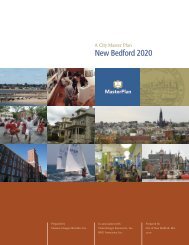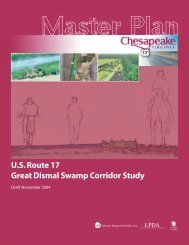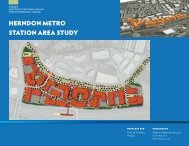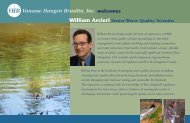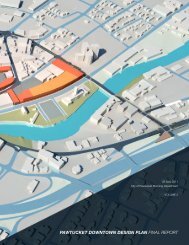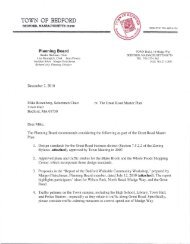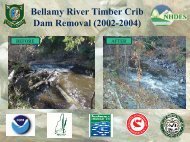Final Report - VHB.com
Final Report - VHB.com
Final Report - VHB.com
You also want an ePaper? Increase the reach of your titles
YUMPU automatically turns print PDFs into web optimized ePapers that Google loves.
scrub-shrub habitat. The largest of the wetlands (wetland 2A-10) is located on the<br />
east side of US Route 201, behind Pine State Safety Lines, Inc. A perennial stream<br />
associated with this wetland originates on the Mount Ararat High School property<br />
and flows south through the wetland.<br />
Farther to the north on US Route 201, two small wetlands are located in the vicinity<br />
of Old Augusta Road. The first (wetland 2A-11) consists of an emergent roadside<br />
ditch adjacent to US Route 201. The second (wetland 2A-12) is located behind a<br />
mobile-home retailer, adjacent to a large open field. Habitat associated with this<br />
wetland is dominated by forested habitat with a small area of open-water habitat.<br />
The northern edge of the wetland consists of a small area of emergent habitat<br />
adjacent to the field.<br />
The eastern portion of this Study Area (i.e., east of the US Route 201/State Route 196<br />
intersection) contains several perennial-stream crossings bordered by narrow bands<br />
of emergent and forested wetland habitat. The largest wetland (2A-13) in this area is<br />
located west of Village Drive and is divided by State Route 196. A perennial-stream<br />
channel, originating on the south side of State Route 196, connects the two wetlands.<br />
The stream flows from southwest to northeast and is a tributary to the Cathance<br />
River.<br />
In addition to the wetlands previously described, several roadside ditches are located<br />
along this corridor, especially between US Route 201 and Village Drive – where a<br />
ditch runs on the north side of the road.<br />
Strategy 2B<br />
Wetland resources in the Strategy 2B Study Area are limited by residential and<br />
<strong>com</strong>mercial development. US Route 1 (Pleasant Street) in Brunswick is almost<br />
entirely built-out on both sides of the road. However, several wetlands systems were<br />
identified in the aerial-photography–interpreted mapping provided by the Town of<br />
Brunswick. The largest system is a forested wetland (wetland 2B-1) located on the<br />
south side of the Exit 28 connector road. The wetland originates along the southern<br />
slope of the Connector Road and extends south to Old Portland Road, where it<br />
outlets to a perennial stream that eventually crosses Pleasant Street and flows into an<br />
emergent wetland.<br />
On the north side of the Connector Road are several small wetlands consisting of<br />
emergent and forested-wetlands habitat that eventually drain to a perennial-stream<br />
channel (wetland 2B-2) . The stream originates as a ditch in the vicinity of a utilityline<br />
corridor that crosses the Exit 28 Connector Road, just west of Pleasant Street. An<br />
emergent wetland (wetland 2B-3) surrounds the stream channel between Pleasant<br />
Street and Range Road. The emergent wetland be<strong>com</strong>es widespread and parallels the<br />
north side of Pleasant Street. The wetland extends out of the Study Area, where it is<br />
associated with the floodplain of the Androscoggin River.<br />
Existing Conditions 45



